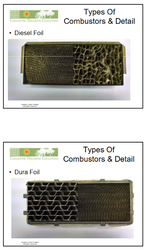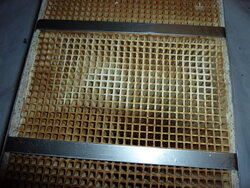jetsam
Minister of Fire
He said it was dieselfoil. I think in a wood stove application, dieselfoil substrates do not have muti-year life expectancies for full time burners. Durafoil is the substrate we're thinking of when we say 'steel cat'.
Deiselfoil combustors should NEVER be used in solid fuel heating. Industry learned this 5+ years ago. They just cannot handle the temps and expansion/contraction rate exceed allowable tolerances.He said it was dieselfoil. I think in a wood stove application, dieselfoil substrates do not have muti-year life expectancies for full time burners. Durafoil is the substrate we're thinking of when we say 'steel cat'.
Deiselfoil combustors should NEVER be used in solid fuel heating. Industry learned this 5+ years ago. They just cannot handle the temps and expansion/contraction rate exceed allowable tolerances.
Now i need to decide if i need to order a new/improved steel converter or to pay a bit more and get an aftermarket ceramic unit. Any advice will be appreciated.

Steel and ceramic both work fine.
Lights off faster at the start of the burn: Steel
Stays active longer at the end of the burn: Ceramic
Less prone to plugging: Ceramic
Practically immune to thermal shock: Steel
Pick your poison- just don't pick dieselfoil.
View attachment 221011
Lack of satisfactory cat suppliers is a serious problem.This is a wearing part. Did you consider other cat suppliers like Condar? Keep us posted on how the Firecat works out, maybe in a new thread.
Let me bump this thread, if you guys don't mind.
Finally the ceramic combustor (that I mentioned in the previous posts) has failed. As I said in previous posts, my experience with the Woodstock OEM stainless, "diesel foil" combustors was very negative but I was willing to try their new Durafoil combustor. It turns out that they have none in stock. The manufacturer they used, failed to supply them with what they wanted but the new manufacturer has been struggling to make an acceptable product.
I had no choice but to order two ceramic elements required for my Woodstock Fireview wood stove for a total of $200 plus $8 for a gasket. I bought it from FireCat. They claim to manufacture high quality elements but I have some doubts after unpacking and inspecting the elements. The "wash" with the precious metals was applied very unevenly. There is none inside the ceramic tubes. Most of the catalytic metals were applied to the element edges that will never be exposed to the gases because it's where the gasket goes. Perhaps i expect too much from a stove catalyst manufacturer but I'm beginning to really doubt my decision to purchase the Woodstock Fireview stove. There are too many design flaws in the product that has been on the market for so long.
I have really been considering to sell the Fireview and get a Jotul non-catalytic stove. I won't have to worry about uneven burn in the Fireview due to poor combustion air distribution and I'll be able to burn the Jotul continuously. The Fireview has no ash pan and can only be used for several days before it gets full of ash. It's a beautiful stove but such a pain in the arse to use.
There are too many design flaws in the product that has been on the market for so long.
I read here recently that Woodstock is taking steps..I thought the post said something about them wanting to do some of the assembly work in-house?Durafoil combustor. It turns out that they have none in stock. The manufacturer they used, failed to supply them with what they wanted but the new manufacturer has been struggling to make an acceptable product.
I ordered a ceramic from them as well, for the Buck 91, and saw the same thing, except it wasn't sprayed on the edge that I noticed since the cat was "canned" in a stainless shell. You can see some inside the cells in this pic, but a lot of other areas, it wasn't in the cells, just on the face. The combustor worked fine though, so I guess they get enough on there for it to work for the specified time. Put it in and run it.I had no choice but to order two ceramic elements...I bought it from FireCat. They claim to manufacture high quality elements but I have some doubts after unpacking and inspecting the elements. The "wash" with the precious metals was applied very unevenly. There is none inside the ceramic tubes. Most of the catalytic metals were applied to the element edges that will never be exposed to the gases because it's where the gasket goes.

Well, I'm not a big fan of shoveling ashes either, and went from the Fireview to the Keystone to get the ash grate and bigger window. You could make that switch, provided the Keystone will handle your house sq.ft. It is a notch down in output from the Fireview.uneven burn in the Fireview due to poor combustion air distribution and I'll be able to burn the Jotul continuously. The Fireview has no ash pan and can only be used for several days before it gets full of ash. It's a beautiful stove but such a pain in the arse to use.
They claim to manufacture high quality elements but I have some doubts after unpacking and inspecting the elements. The "wash" with the precious metals was applied very unevenly. There is none inside the ceramic tubes. Most of the catalytic metals were applied to the element edges that will never be exposed to the gases because it's where the gasket goes.
I'm running a firecat ceramic combustor right now, it's about at half of the expected life. The OEM was a firecat ceramic, then I went steel, and now back to firecat ceramic. They've been great and inexpensive from firecat.[/QUOTE
which one ya like the best?
which one ya like the best?
how about the ashford? steel or ceramic? Also I've wondered why BK used steel in one and ceramic in the other
It had been mentioned in the past inconsistencies in color of the brand new cats didn’t mean the wash coat was applied uneven, or considered defective.
In the pic I posted above, it was obvious when observed first-hand, that the ceramic was all one color, no variation, and the catalyst was the stuff that appeared to be sprayed on. I didn't read that previous post about this, and who made those combustors. Both our combustors came from firecat so I'm assuming that he is seeing what I saw. I guess in some cases, the wash coat (what is applied to the ceramic so that the catalyst can stick to it) may have color variation. I didn't see that on the firecats though..It had been mentioned in the past inconsistencies in color of the brand new cats didn’t mean the wash coat was applied uneven, or considered defective.
You can pretty easily run the Fireview on 13.5' of stack, which is what my BIL has on my old stove. He had one back-puff, and as far as I could determine, he cut the air too far, too soon before he had the load burning well, and it was 50* out. I never had a back-puff when I ran it here on 16', even when warm out. You do have to get the load burning and the cat cranking first, though.I have only seen two complaints ever lodged against the Fireview, with any frequency, in all of the tens of thousands of posts I have read on this forum:
1. They might be prone to back-puffing at the lowest burn rate on shorter chimneys. A few users have had that issue, but unfortunately the one that was most prolific on the subject was deleted from the archives.
2. They have or had a screen upstream of the combustor, which tended to clog with fly ash. It was always reported as something simple to clean, but caused much frustration for the few users experiencing it. I suspect these might have been users with unusually tall chimneys, high draft condition.

OK, so the wash coat has the catalyst mixed in, and then it's sprayed on, as seen in my pic above? It was mostly white, only brown on the face, with some spray down into some of the cells. If you look closely, you can see that some cells have no catalyst/wash coat inside them at all, and are white down in there.You cannot see the catalyst (palladium and platinum). You can see wash coat. In 25 years I have yet to see a ceramic combustor where the color was uniform. There is, to the human eye, no way to predict combustor performance based upon color/pattern. I will admit if you see one that is completely white...it probably does not have any application of wash coat (which carries the precious metals)
I'm interested in this as well.OK, so the wash coat has the catalyst mixed in, and then it's sprayed on, as seen in my pic above? It was mostly white, only brown on the face, with some spray down into some of the cells. If you look closely, you can see that some cells have no catalyst/wash coat inside them at all, and are white down in there.
So now I'm thinking that even though the catalyst isn't coating anywhere near all of the ceramic, once the catalyst starts burning smoke, the rest of the ceramic will get hot and eventually glow, even though it may have no catalyst on it. And if the ceramic is 1000-1500* and glowing, it is burning the smoke inside the cells, even though there's no catalyst in there..?

